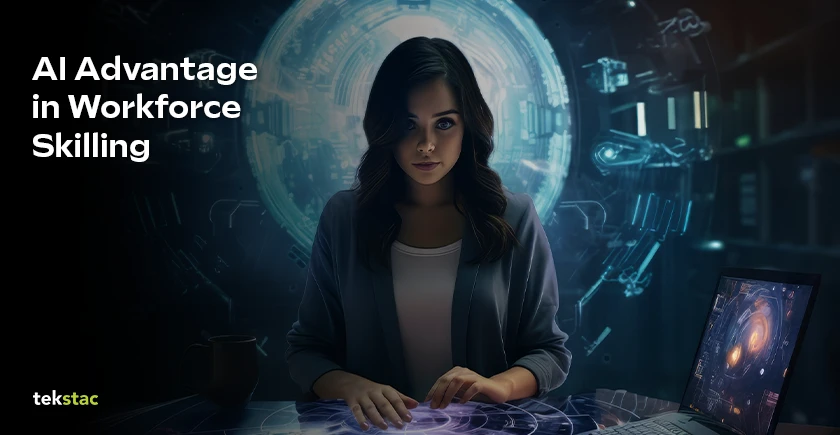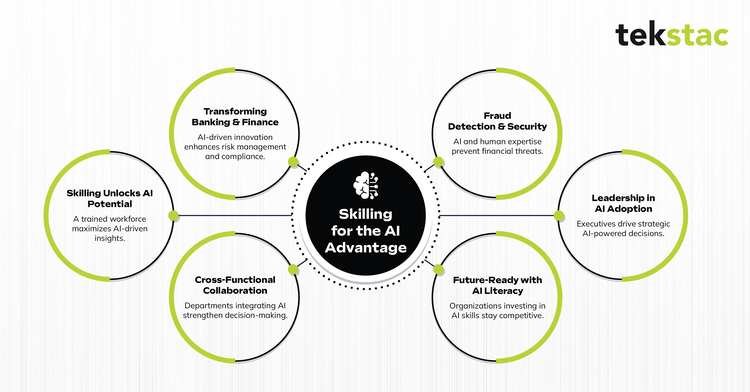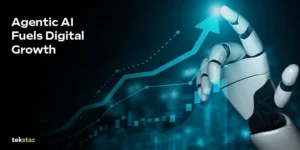The Unseen War for Invisible Capabilities: Why Skilling Is the Real AI Advantage
March 21, 2025

AI Advantage in Banking & Finance
In banking and financial services, we often talk about the next wave of AI—cutting-edge models, predictive analytics, conversational interfaces. Yet, the most consequential AI applications aren’t the flashy ones. They’re the invisible capabilities woven into the daily flow of risk management, compliance checks, and customer engagement decisions. These capabilities don’t call attention to themselves, but they quietly outmanoeuvre the competition by catching small signals of change and acting before anyone else.
AI Advantage Through Workforce Skilling
Beneath the surface of this transformation lies a critical truth: no algorithm can deliver its full value unless people know how to use it. Tools can be copied or bought off the shelf, but a well-trained workforce—one that intuitively applies AI insights at the right moment—is nearly impossible to replicate. This is where the real battle is being fought.
AI Advantage in Fraud Detection & Security
Take fraud detection as an example. Many banks invest in sophisticated models to flag suspicious transactions. But the difference between an automated alert and a decisive, pre-emptive intervention often comes down to human expertise. A fraud analyst who understands the nuances of emerging schemes can override or refine an AI recommendation, catching anomalies that a generic algorithm might miss. That analyst isn’t simply following a script; they’re applying domain knowledge and pattern recognition developed over time.
The same holds true for risk officers who rely on AI-driven early warning systems or relationship managers who use AI cues to personalize outreach. The banks that stand apart are those whose employees can interpret these cues and turn them into action—before the competition even knows an opportunity or threat exists.

AI Advantage in Cross-Functional Collaboration
To build this level of skill, organizations need more than classroom training on “AI 101.” They require a cultural shift where continuous learning is embedded into everyone’s job. Instead of seeing AI as a black box, people need to understand how models are developed and, crucially, where they might fail. That means creating environments where it’s acceptable to question AI outputs, run parallel checks, and propose alternative theories.
One way to make this happen is to encourage cross-functional rotations: let a credit underwriter spend time with the data science team, or a compliance officer rotate through the fraud unit. When employees see how each part of the organization uses AI, they develop a richer mental model of both the tools and the risks involved. Over time, this cross-pollination builds a shared language around AI that breaks down silos and unearths opportunities no single department could spot alone.
AI Advantage in Leadership & Decision-Making
Mentorship programs can further accelerate this process. A veteran risk analyst who has navigated multiple market cycles can coach younger colleagues on what subtle signals to watch for in AI-driven dashboards. That institutional wisdom, paired with cutting-edge analytics, becomes a powerful edge that can’t be copied by a competitor simply purchasing the same software.
At the leadership level, executives play a pivotal role in signaling the importance of human oversight in AI decisions. Instead of treating models as the final word, they should champion the idea that AI augments, rather than replaces, professional judgment. When a compliance manager or relationship banker sees leaders regularly engage with AI outputs—asking tough questions, challenging assumptions, interpreting findings—they learn that curiosity and rigorous thinking aren’t just tolerated but actively encouraged.
The Invisible AI Advantage: Winning the Competitive Battle
Over time, these behaviors create a workforce that doesn’t passively accept predictions but proactively looks for gaps in the data, biases in the model, or new patterns of fraud. The result is an organization whose AI capabilities remain largely invisible to the outside world—there’s no flashy rollout, but the performance gains are undeniable.
Customers may notice fewer hiccups and a smoother experience, but they won’t see the invisible engine that keeps fraud at bay, compliance strong, and offerings finely tuned to their needs. Rivals, meanwhile, will struggle to pin down what makes this bank or insurer so consistently agile.
The Linchpin of AI Success
In this new era, skilling is the linchpin of AI success. Traditional training programs and vendor-led implementations aren’t enough. True competitive advantage demands a workforce that thinks and reacts in concert with AI, forming a quietly unstoppable partnership. Whether it’s thwarting fraud attacks before they surface or reading subtle market cues that others overlook, the organizations that invest seriously in upskilling and cultural transformation will outpace those that treat AI as a technology project alone.
And that is the essence of the unseen war: the real battle lines are drawn around the workforce. As soon as you embed AI literacy and a questioning mindset into every level of your organization, you’ll find yourself not just meeting the market’s demands but predicting them—often before anyone else even knows those demands exist.





